Jules Reynal Roche Fermoy de Saint-Michel was born in Martinique in 1838 and came to the Unites States in 1848. He married Nathalie Florence Higgins (1848-1901). They were the parents of Mathilde Reynal, the wife of Paul Gilbert Thebaud, Sr., they of the stolen jewels.
Several members of the Renal family used the full form of their name – Reynal Roche Fermoy de Saint-Michel – or insisted of the French pronunciation of their first and last names. New Yorkers found this insufferably pretentious. But if my last name were Reynal Roche Fermoy de Saint-Michel I would be strongly tempted to flaunt it in the faces of all the Smiths and Joneses, not to mention the van-Thises and the van-Thats.
Jules, according to a descendent, was “a poor but noble Frenchman, descended from French Huguenots from Normandy.” His ancestor had come from China to New York in 1771. His wife came from a wealthy family. Her father, Nathaniel Higgins, a carpet manufacturer, in 1882 left $1,500,000 (c. $35,000,000 in 2015 dollars) to the Reynal children. When Jules Reynal died in 1894, he left an estate of only $50,000.
As my wife has noticed, her New York family were the Kardashians of their day. A marital spat and the separation of Jules and Natalie were detailed in the papers. Nathalie remained in the Madison Avenue townhouse with the children while Jules moved to a hotel. But in 1894 he became ill; the children, although members of the jeunesse doree, as the papers put it, and his alienated wife nursed him, and all was well and everyone went to the country seat Rocky Dell, in Westchester County.
Rocky Dell
There Jules and his son Eugene after him were masters of hound with the Westchester Hunt Club. Jules commisoned portraits of his dogs from Arthur Fitzwilliam Tait.
In September 1879, Jules shot a three-legged woodcock near his house in White Plains; it made it into the Scientific American.
Genuine Three-Legged Woodcock
Nathalie was a great tea and luncheon giver.
In 1889 she offered lunch to 90 ladies at 14 tables.
In the centre of each was a large Dresden candelabrum, with wax lights, each light having a delicate satin shade. The menu was printed on the inside of folding tablets, the exterior of which was of red satin. The family monogram was painted on each in gold, and the name of the guest was underneath the monogram. The floral favors were in the form of gentlemen’s hats, Indian hampers, and double baskets. These were all filled with the choicest flowers of the season.
A notable feature of the occasion was the elegance of the toilets.
The papers detailed the arrangements of an 1896 affair:
Some of the twenty matrons who attended the mauve luncheon insist it was one of the prettiest ever given in town. It was mauve and gold, and mostly the latter. All the plates that were not gold were mauve color. Even the ices were mauve colored, and a great mound of the lavender orchids was on the table. Clusters of these tied with a ribbon to match were at each place.
Nathalie summered (note teh Wasp verb) at Bar Harbor, first at Ban-Y-Bryn:
Designed by Architect S. V. Stratton, Ban-y-Bryn was built on a steep bluff, with the front of the cottage facing the rustic Maine landscape. The rear of the home, with its prominent turret and several grand porches, overlooked Frenchman’s Bay. Rising to four stories, the home consisted of 27 rooms, including seven bedrooms, five bathrooms, five fireplaces, a large stable, seven servants’ bedrooms, and additional servants’ facilities.
And then at Cornersmeet. There she got into trouble.
Her doctor had told her to eat s partridge a day. She served twenty-five of them out of season in September 1889. The Maine State Game Warden heard about it, and called at Cornersmeet. The housekeeper confessed, Nathalie ended up paying a fine of $254 and stormed out of Bar Harbor, threatening never to return. Society was aghast.
All day society has been indignantly discussing the “outrage,” and the opinion has become quite thoroughly crystallized that a law which attempts to obstruct the gastronomic enjoyment of people is a baneful one.
In March 1901 Mrs Reynal, her son Eugene Sugny, and his fiancée Adeleide Fitzgerald were at Gedney Farms the home of the Willets (where the theft of the Thebaud jewels would later occur). Eugene and Adelaide both came down with scarlet fever and the house was quarantined. Eugene at first recovered but then started failing. A priest was summoned to administer last rites to Eugene. Adelaide was alarmed, and without telling the parents, had the priest marry them in the sick room, with only the doctor and nurse as witnesses.
Nathalie built the church of St. John the Evangelist in White Plains as a memorial to her son Jules, who died as a child. She bought the land, built the church, furnished it, and turned it over to the congregation debt-free in 1892. She was buried from there after her death on May 2, 1901.
St .John the Evangelist
In 1910 the New York, Westchester, and Boston Railroad, a J. P. Morgan folly, wanted to build a line through Rocky Dell. The then-owner, Nathaniel Reynal, would not sell a right of way because the railroad would be within a few hundred feet of his house, and the railroad did not want to buy the whole estate.
Change was inevitable, and the Reynal estate was subdivided.
It is now the Rocky Dell and Reynal Park neighborhoods.
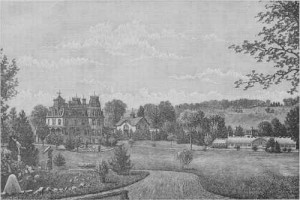

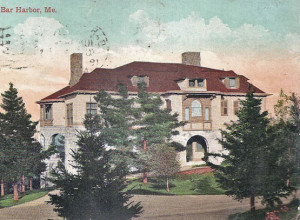
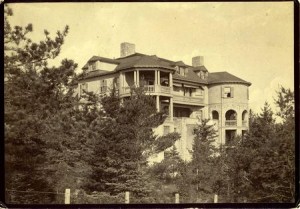
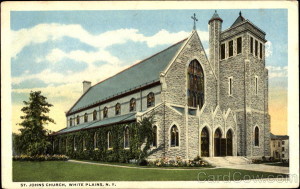
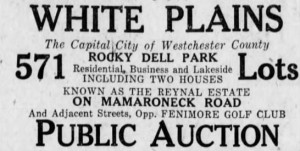
I like to see historical.Love to Jesus Christ.
One of the sins was Eugene, and when we moved into Reynal Park, we were told the streets were named after family members. That would explain Gene Place, but there are still Kenneth, Meda, Susan Court, Amy and Hewitt. What were Eaugene’s sibling’s names of maybe the names of the generation after Eugene?
Also, there is a small ruin at the top of the wooded hill that kids used to call “The fort” It really is old stone stairs and a wall…looks like part of a foundation. I was told when I was little that it was part of the Reynal mansion. There also were wonderful ruins of a smoke house/pump house down by the river that I have photos of. The city of White Plains destroyed it and threw out the pieces when someone moved into the neighborhood and complained about kids who went in it.
When my house was built in the late fifties, there was a stone boat house on the river, but the city destroyed that, too.
There still are beautiful old stone bridges that I believe are remnants of the days of the estate, but I can’t prove it as the oldest map I have found with the bridge behind my house on it is from the thirties. The city tried to have the bridge behind my house destroyed because a builder who made a land purchase ignorantly was hinting at suing the city. The head of Public Works at the time, Bud Nicoletti was saying that the bridge was not even 50 years old (ignorant about Rocky Dell history, but opinionated and well-paid)x The bridge still stands, but there were closed-door meetings discussing the removal of it. That bridge is behind 42 Reynal, and a larger bridge is behind 44 Reynal. They are visible from the parkland and can be seen without trespassing. Just walk along the river in the woods and you’ll see the 2 old bridges. If anyone would like me to point out where the ruins of out old “fort” are, email me at Paulapiekos@aol.com and I’ll show it to you.